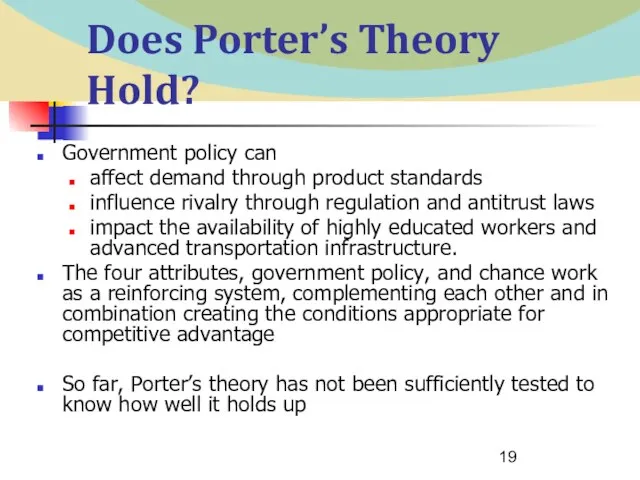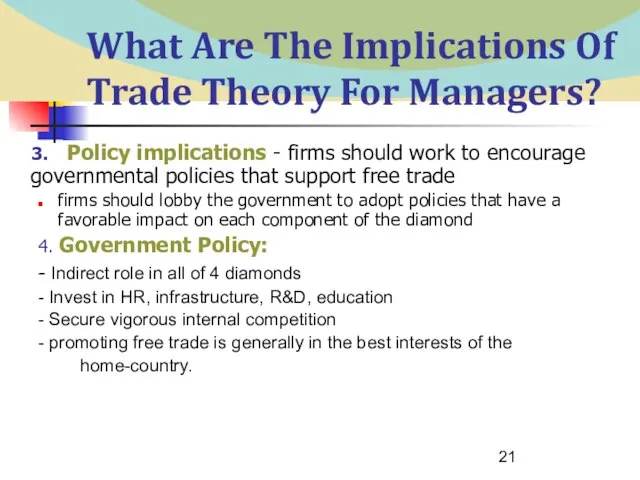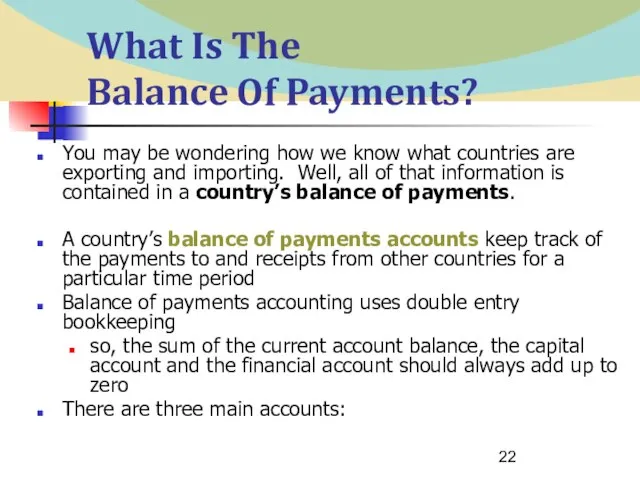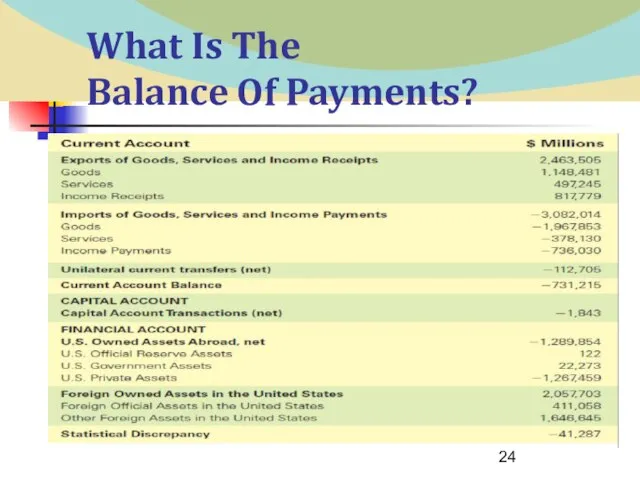Слайд 2Lecture 8
Trade Theories:
Mercantilism
Absolute Advantage
Comparative Advantage
Factor proportion Trade
International Product Cycle
New Trade Theory
National

Competitive Advantage
Слайд 3What Is New Trade Theory?
In an effort to resolve some of the

shortcomings of other theories, researchers in the 1970s began to search for other explanations of trade.
New trade theory suggests that the ability of firms to gain economies of scale (unit cost reductions associated with a large scale of output) can have important implications for international trade
Слайд 4New Trade Theory
Achieving economies of scale can be very important to firms.

Microsoft for example, is able to spread the costs of developing new versions of Windows over millions of PCs.
Why is this important?
Suppose we live in a world without trade.
Small markets might find that they don’t have certain products available if producers can’t sell enough to achieve economies of scale, or if the products are available, prices will probably be very high.
But, if countries trade with each other, markets are bigger, and firms have the opportunity to sell enough to achieve scale economies.
Consumers have more choice and lower prices!
Слайд 5New Trade Theory
Through its impact on economies of scale, trade can increase

the variety of goods available to consumers and decrease the average cost of those goods
without trade, nations might not be able to produce those products where economies of scale are important
with trade, markets are large enough to support the production necessary to achieve economies of scale
so, trade is mutually beneficial because it allows for the specialization of production, the realization of scale economies, and the production of a greater variety of products at lower prices
Слайд 6New Trade Theory
In some industries, to achieve economies of scale, firms have

to have a major share of the world’s market.
The costs of developing new aircraft, for example, are so high, that firms have to hold a significant share of the world market in order to gain economies of scale.
Remember, that there are only two makers of large commercial aircraft in the world!
In those industries when output required to attain economies of scale represents a significant proportion of total world demand, the global market may only be able to support a small number of enterprises
first mover advantages - the economic and strategic advantages that accrue to early entrants into an industry
Слайд 7New Trade Theory
It’s important to consider the effects of first mover advantages

because the pattern of trade we see in the world economy may be the result of first mover advantages and economies of scale.
Firms that achieve first mover advantages will develop economies of scale, and create barriers to entry for other firms.
Airbus, for example, is currently enjoying the first mover advantages associated with its super jumbo plane.
Airbus has to sell at least 250 super jumbos just to break even on the project.
The market over the next twenty years is expected to be just 400 to 600 planes, so it’s not worthwhile for Boeing to even get in the market.
Airbus has first mover advantages based on scale economies.
Слайд 8What Are The Implications Of
New Trade Theory For Nations?
Nations may

benefit from trade even when they do not differ in resource endowments or technology
a country may dominate in the export of a good simply because it was lucky enough to have one or more firms among the first to produce that good
Governments should consider strategic trade policies that nurture and protect firms and industries where first mover advantages and economies of scale are important
Слайд 9National’s Comperative Advantage
Have you ever wondered why some countries have certain

industries that seem to be superior to those of other countries? Why for example, is Japan so strong in the global auto industry? Why does Switzerland dominate the pharmaceutical industry?
These are questions that intrigued Michael Porter, who in 1990, believing that the theories at the time still left gaps in our understanding of trade patterns, tried to explain why a country might achieve international success in a particular industry.
Porter identified four factors that he argued promoted or impeded the creation of competitive advantage in an industry.
Together, he called these factors the diamond of competitive advantage.
Слайд 10National Competitive Advantage: Porter’s Diamond
Michael Porter: The Competitive Advantage of Nations (1990).
Question:

“Why particular countries succeed in particular industries?”
He studied 100 industries in 10 nations and found four broad attributes that promote or impede the creation of national competitive advantage.
Слайд 11What Is Porter’s Diamond Of Competitive Advantage?
Michael Porter tried to explain why

a nation achieves international success in a particular industry and identified four attributes that promote or impede the creation of competitive advantage
Factor endowments - a nation’s position in factors of production necessary to compete in a given industry
can lead to competitive advantage
can be either basic (natural resources, climate, location) or advanced (skilled labor, infrastructure, technological know-how)
Demand conditions - the nature of home demand for the industry’s product or service
influences the development of capabilities
sophisticated and demanding customers pressure firms to be competitive
Слайд 12What Is Porter’s Diamond Of Competitive Advantage?
Relating and supporting industries - the

presence or absence of supplier industries and related industries that are internationally competitive
can spill over and contribute to other industries
successful industries tend to be grouped in clusters in countries
Firm strategy, structure, and rivalry - the conditions governing how companies are created, organized, and managed, and the nature of domestic rivalry
different management ideologies affect the development of national competitive advantage
vigorous domestic rivalry creates pressures to innovate, to improve quality, to reduce costs, and to invest in upgrading advanced features
Слайд 13What Is Porter’s Diamond Of Competitive Advantage?
Determinants of National Competitive Advantage: Porter’s

Diamond
Слайд 14Determinants of National Competitive Advantage
Factor endowments
Factor endowments: nation’s position in factors

of production such as skilled labor or infrastructure necessary to compete in a given industry.
Basic factors:
natural resources,
climate,
Location
Advanced factors:
communications,
skilled labor,
technology.
Слайд 15Determinants of National Competitive Advantage
Demand conditions
Demand conditions: the nature of home

demand for the industry’s product or service.
Demand creates the capabilities.
Look for sophisticated and demanding consumers.
impacts quality and innovation.
Слайд 16Determinants of National Competitive Advantage
Firm strategy, structure and rivalry
Firm strategy, structure

and rivalry: the conditions in the nation governing how companies are created, organized, and managed and the nature of domestic rivalry.
Firms that face strong domestic competition will be better able to face competitors from other firms.
Слайд 17Determinants of National Competitive Advantage
Related and supporting industries
Related and supporting industries:

the presence or absence in a nation of supplier industries or related industries that are internationally competitive.
Creates clusters of supporting industries that are internationally competitive.
Cost-effective input, information, exchange of ideas and information.
Source of innovation and upgrading.
Слайд 18Overview Of Trade Theory
National Competitive Advantage: Porter’s Diamond
In addition to these

four main attributes, government policies and chance can impact any of the four.
Government policy can affect demand through product standards, influence rivalry through regulation and antitrust laws, and impact the availability of highly educated workers and advanced transportation infrastructure.
The four attributes of the diamond, government policy, and chance work as a reinforcing system, complementing each other and in combination creating the conditions appropriate for competitive advantage.
The Management Focus on Nokia provides a good example of how this Finnish firm built its competitive advantage as a result of factors in Porter’s diamond.
Слайд 19Does Porter’s Theory Hold?
Government policy can
affect demand through product standards
influence rivalry through

regulation and antitrust laws
impact the availability of highly educated workers and advanced transportation infrastructure.
The four attributes, government policy, and chance work as a reinforcing system, complementing each other and in combination creating the conditions appropriate for competitive advantage
So far, Porter’s theory has not been sufficiently tested to know how well it holds up
Слайд 20What Are The Implications Of Trade Theory For Managers?
Location implications - a

firm should disperse its various productive activities to those countries where they can be performed most efficiently
firms that do not, may be at a competitive disadvantage
First-mover implications - Being a first mover can have important competitive implications, especially if there are economies of scale and the global industry will only support a few competitors. Firms need to be prepared to undertake huge investments and suffer losses for several years in order to reap the eventual rewards.
Слайд 21What Are The Implications Of Trade Theory For Managers?
3. Policy implications

- firms should work to encourage governmental policies that support free trade
firms should lobby the government to adopt policies that have a favorable impact on each component of the diamond
4. Government Policy:
- Indirect role in all of 4 diamonds
- Invest in HR, infrastructure, R&D, education
- Secure vigorous internal competition
- promoting free trade is generally in the best interests of the
home-country.
Слайд 22What Is The
Balance Of Payments?
You may be wondering how we know

what countries are exporting and importing. Well, all of that information is contained in a country’s balance of payments.
A country’s balance of payments accounts keep track of the payments to and receipts from other countries for a particular time period
Balance of payments accounting uses double entry bookkeeping
so, the sum of the current account balance, the capital account and the financial account should always add up to zero
There are three main accounts:
Слайд 23What Is The
Balance Of Payments?
The current account records transactions that pertain

to goods, services, and income, receipts and payments
current account deficit - a country imports more than it exports
current account surplus – a country exports more than it imports
The capital account records one time changes in the stock of assets
The financial account records transactions that involve the purchase or sale of assets
net change in U.S. assets owned abroad
foreign owned assets in the United States
Слайд 24What Is The
Balance Of Payments?
United States Balance of Payments Accounts, 2007
























 Защита Практики
Защита Практики ПОДВОДНЫЙ МИР
ПОДВОДНЫЙ МИР Понятие площади и объёма
Понятие площади и объёма Гражданское право как отрасль права
Гражданское право как отрасль права И.С.Тургенев: жизнь и творчество
И.С.Тургенев: жизнь и творчество Итоги Шестой рамочной программы Евросоюза для российских организаций. Новые возможности участия в Седьмой рамочной программе М
Итоги Шестой рамочной программы Евросоюза для российских организаций. Новые возможности участия в Седьмой рамочной программе М Организация работы железнодорожных станций. Регламент переговоров ДСП станции, машинистов и составителя поездов при работе
Организация работы железнодорожных станций. Регламент переговоров ДСП станции, машинистов и составителя поездов при работе Управление муниципальных закупок (уполномоченный орган администрации города Сочи в сфере размещения муниципального заказа )
Управление муниципальных закупок (уполномоченный орган администрации города Сочи в сфере размещения муниципального заказа ) Особенности строения земноводных
Особенности строения земноводных Отношение композиторов и художников к родной природе, духовным образам древнерусского и западноевропейского искусства
Отношение композиторов и художников к родной природе, духовным образам древнерусского и западноевропейского искусства ОБЩЕСТВО С ОГРАНИЧЕННОЙ ОТВЕТСТВЕННОСТЬЮ
ОБЩЕСТВО С ОГРАНИЧЕННОЙ ОТВЕТСТВЕННОСТЬЮ Phantom4PPK -решение для получения геодезически точных ортофотопланов, цифровых моделей местности
Phantom4PPK -решение для получения геодезически точных ортофотопланов, цифровых моделей местности Hi-Tech show Rocketman
Hi-Tech show Rocketman Организменная среда обитания
Организменная среда обитания Как я провёл это лето
Как я провёл это лето  Организационная структура отдела TRIM LINE
Организационная структура отдела TRIM LINE ДЕЯТЕЛЬНОСТЬ МЕЖССУЗОВСКОЙ ИНФОРМАЦИОННОЙ СЕТИ
ДЕЯТЕЛЬНОСТЬ МЕЖССУЗОВСКОЙ ИНФОРМАЦИОННОЙ СЕТИ Аммиак 9 класс
Аммиак 9 класс Презентация "Храмы земли Костромской" - скачать презентации по МХК
Презентация "Храмы земли Костромской" - скачать презентации по МХК Особенности работы с различными категориями клиентов
Особенности работы с различными категориями клиентов ПРЕДЛОГИучитель Королева И.И.
ПРЕДЛОГИучитель Королева И.И. Право и другие сферы общества
Право и другие сферы общества Влияние музыки на детей
Влияние музыки на детей Компьютер: враг или помощник
Компьютер: враг или помощник Назови одним словом. Игра
Назови одним словом. Игра Презентация на тему Осенняя корзиночка
Презентация на тему Осенняя корзиночка  Золотое сечение в искусстве
Золотое сечение в искусстве Что такое проект. Классификация проектов
Что такое проект. Классификация проектов